Advance Financial Accounting Assignment: AASB 138 and Superannuation
VerifiedAdded on 2020/03/15
|12
|3221
|38
Homework Assignment
AI Summary
This document presents a comprehensive solution to an Advance Financial Accounting assignment. It begins with a discussion on fair value measurement, including valuation techniques for land, and journal entries for property, plant, and equipment. The assignment delves into the accounting treatment of intangible assets, exploring the impact of internally generated assets under AASB 138/IAS 38, the differences between acquired and internally generated intangibles, and the reasons companies may be reluctant to change. Furthermore, the document provides a detailed analysis of a defined benefit superannuation plan, including calculations for surplus/deficit, net asset/liability, net interest, and reconciliation of balances, along with the corresponding journal entries. The solution incorporates references to relevant accounting standards and literature.

Running head: ADVANCE FINANCIAL ACCOUNTING
Advance Financial Accounting
Name of the Student:
Name of the University:
Authors Note:
Advance Financial Accounting
Name of the Student:
Name of the University:
Authors Note:
Paraphrase This Document
Need a fresh take? Get an instant paraphrase of this document with our AI Paraphraser

ADVANCE FINANCIAL ACCOUNTING
1
Table of Contents
Question 1: Stating the measures used in identifying fair value................................................2
Question 2:.................................................................................................................................3
1. Peewee Ltd journal entries for the year ended 30 June 2017:................................................3
2. Peewee Ltd journal entries for the year ended 30 June 2018:................................................4
Question 3:.................................................................................................................................6
1. Stating the impact of internally generated intangible assets in AASB 138/IAS 38:..............6
2. Difference between accounting for internally generated intangible assets and acquired
intangible assets in AASB 138/IAS 38:.....................................................................................7
3. Mentioning the reasons behind companies being reluctant to change in AASB 138/IAS 38:
....................................................................................................................................................7
Question 4:.................................................................................................................................8
1. Revealing the surplus or deficit of Wattle Ltd’s defined benefit plan at 31 December 2016:
....................................................................................................................................................8
2. Mentioning the net defined benefit asset or liability at 31 December 2016:.........................9
3. Stating the net interest and the return on plan assets in 31 December 2016:.........................9
4. Providing reconciliation regarding opening balance and closing balance of the net defined
benefit liability:..........................................................................................................................9
5. Drafting journal entry to defined benefit superannuation plan in the books of Wattle Ltd for
the year ended 31 December 2016:..........................................................................................10
Reference and Bibliography:....................................................................................................12
1
Table of Contents
Question 1: Stating the measures used in identifying fair value................................................2
Question 2:.................................................................................................................................3
1. Peewee Ltd journal entries for the year ended 30 June 2017:................................................3
2. Peewee Ltd journal entries for the year ended 30 June 2018:................................................4
Question 3:.................................................................................................................................6
1. Stating the impact of internally generated intangible assets in AASB 138/IAS 38:..............6
2. Difference between accounting for internally generated intangible assets and acquired
intangible assets in AASB 138/IAS 38:.....................................................................................7
3. Mentioning the reasons behind companies being reluctant to change in AASB 138/IAS 38:
....................................................................................................................................................7
Question 4:.................................................................................................................................8
1. Revealing the surplus or deficit of Wattle Ltd’s defined benefit plan at 31 December 2016:
....................................................................................................................................................8
2. Mentioning the net defined benefit asset or liability at 31 December 2016:.........................9
3. Stating the net interest and the return on plan assets in 31 December 2016:.........................9
4. Providing reconciliation regarding opening balance and closing balance of the net defined
benefit liability:..........................................................................................................................9
5. Drafting journal entry to defined benefit superannuation plan in the books of Wattle Ltd for
the year ended 31 December 2016:..........................................................................................10
Reference and Bibliography:....................................................................................................12
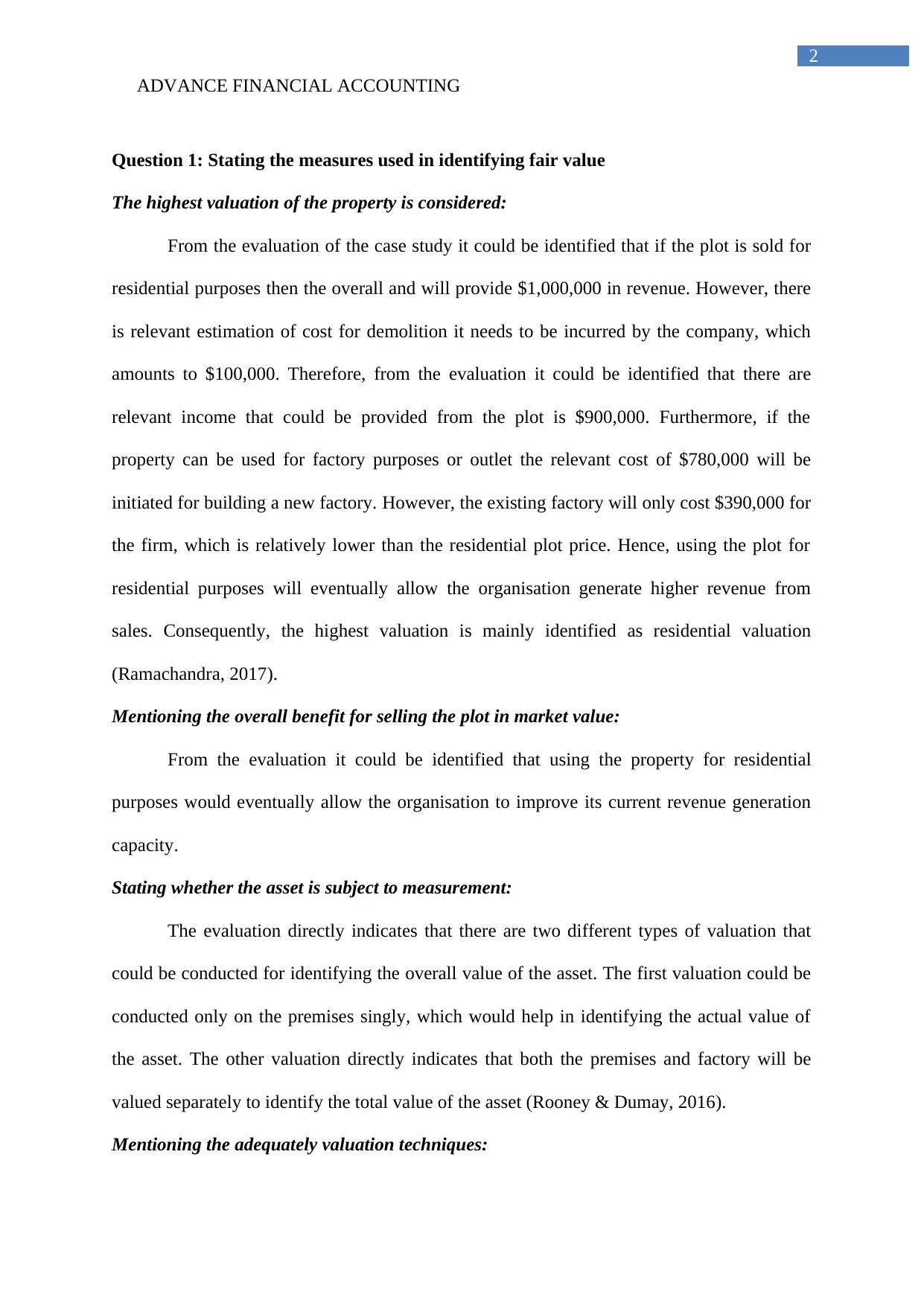
ADVANCE FINANCIAL ACCOUNTING
2
Question 1: Stating the measures used in identifying fair value
The highest valuation of the property is considered:
From the evaluation of the case study it could be identified that if the plot is sold for
residential purposes then the overall and will provide $1,000,000 in revenue. However, there
is relevant estimation of cost for demolition it needs to be incurred by the company, which
amounts to $100,000. Therefore, from the evaluation it could be identified that there are
relevant income that could be provided from the plot is $900,000. Furthermore, if the
property can be used for factory purposes or outlet the relevant cost of $780,000 will be
initiated for building a new factory. However, the existing factory will only cost $390,000 for
the firm, which is relatively lower than the residential plot price. Hence, using the plot for
residential purposes will eventually allow the organisation generate higher revenue from
sales. Consequently, the highest valuation is mainly identified as residential valuation
(Ramachandra, 2017).
Mentioning the overall benefit for selling the plot in market value:
From the evaluation it could be identified that using the property for residential
purposes would eventually allow the organisation to improve its current revenue generation
capacity.
Stating whether the asset is subject to measurement:
The evaluation directly indicates that there are two different types of valuation that
could be conducted for identifying the overall value of the asset. The first valuation could be
conducted only on the premises singly, which would help in identifying the actual value of
the asset. The other valuation directly indicates that both the premises and factory will be
valued separately to identify the total value of the asset (Rooney & Dumay, 2016).
Mentioning the adequately valuation techniques:
2
Question 1: Stating the measures used in identifying fair value
The highest valuation of the property is considered:
From the evaluation of the case study it could be identified that if the plot is sold for
residential purposes then the overall and will provide $1,000,000 in revenue. However, there
is relevant estimation of cost for demolition it needs to be incurred by the company, which
amounts to $100,000. Therefore, from the evaluation it could be identified that there are
relevant income that could be provided from the plot is $900,000. Furthermore, if the
property can be used for factory purposes or outlet the relevant cost of $780,000 will be
initiated for building a new factory. However, the existing factory will only cost $390,000 for
the firm, which is relatively lower than the residential plot price. Hence, using the plot for
residential purposes will eventually allow the organisation generate higher revenue from
sales. Consequently, the highest valuation is mainly identified as residential valuation
(Ramachandra, 2017).
Mentioning the overall benefit for selling the plot in market value:
From the evaluation it could be identified that using the property for residential
purposes would eventually allow the organisation to improve its current revenue generation
capacity.
Stating whether the asset is subject to measurement:
The evaluation directly indicates that there are two different types of valuation that
could be conducted for identifying the overall value of the asset. The first valuation could be
conducted only on the premises singly, which would help in identifying the actual value of
the asset. The other valuation directly indicates that both the premises and factory will be
valued separately to identify the total value of the asset (Rooney & Dumay, 2016).
Mentioning the adequately valuation techniques:
⊘ This is a preview!⊘
Do you want full access?
Subscribe today to unlock all pages.

Trusted by 1+ million students worldwide
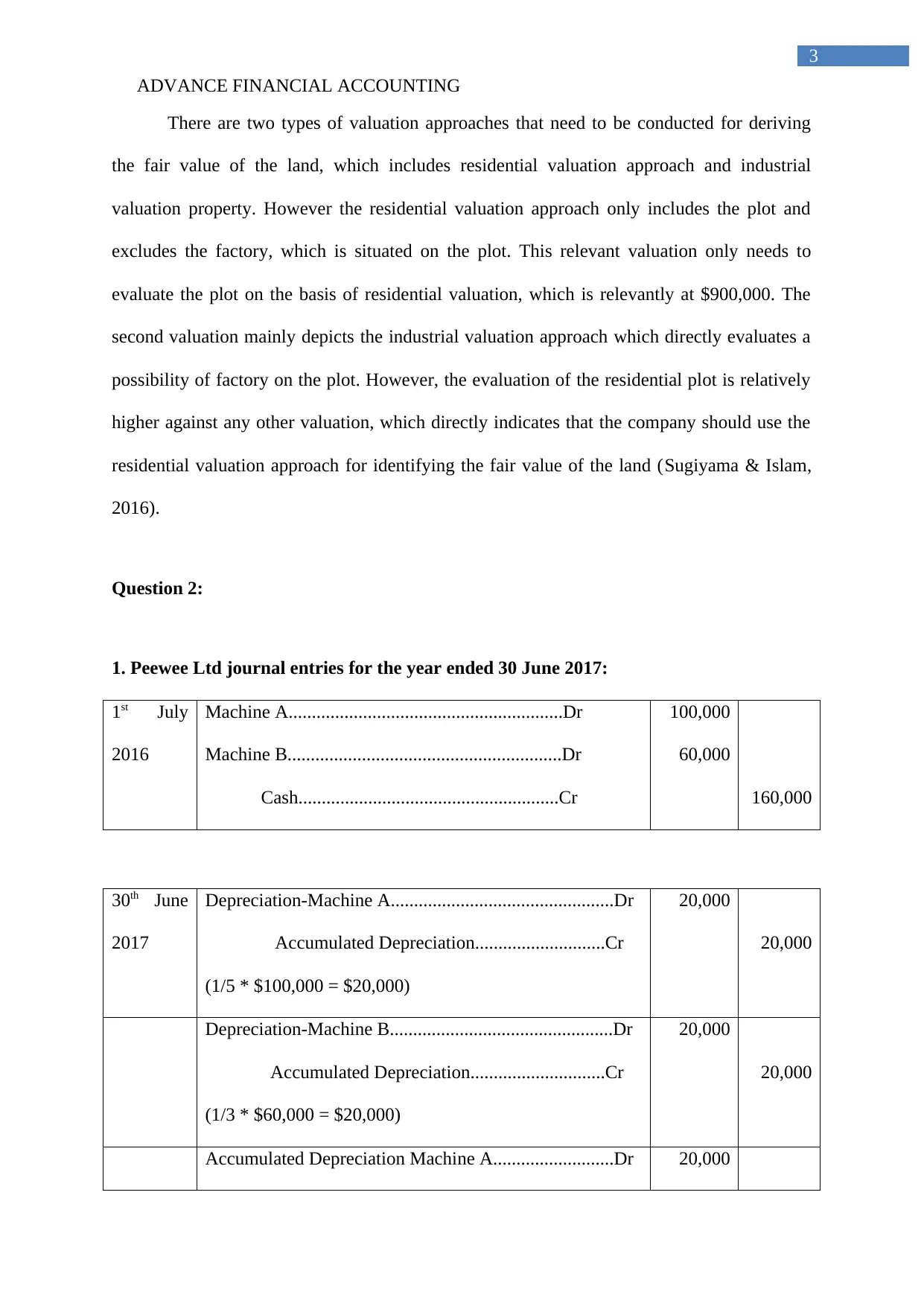
ADVANCE FINANCIAL ACCOUNTING
3
There are two types of valuation approaches that need to be conducted for deriving
the fair value of the land, which includes residential valuation approach and industrial
valuation property. However the residential valuation approach only includes the plot and
excludes the factory, which is situated on the plot. This relevant valuation only needs to
evaluate the plot on the basis of residential valuation, which is relevantly at $900,000. The
second valuation mainly depicts the industrial valuation approach which directly evaluates a
possibility of factory on the plot. However, the evaluation of the residential plot is relatively
higher against any other valuation, which directly indicates that the company should use the
residential valuation approach for identifying the fair value of the land (Sugiyama & Islam,
2016).
Question 2:
1. Peewee Ltd journal entries for the year ended 30 June 2017:
1st July
2016
Machine A...........................................................Dr
Machine B...........................................................Dr
Cash........................................................Cr
100,000
60,000
160,000
30th June
2017
Depreciation-Machine A................................................Dr
Accumulated Depreciation............................Cr
(1/5 * $100,000 = $20,000)
20,000
20,000
Depreciation-Machine B................................................Dr
Accumulated Depreciation.............................Cr
(1/3 * $60,000 = $20,000)
20,000
20,000
Accumulated Depreciation Machine A..........................Dr 20,000
3
There are two types of valuation approaches that need to be conducted for deriving
the fair value of the land, which includes residential valuation approach and industrial
valuation property. However the residential valuation approach only includes the plot and
excludes the factory, which is situated on the plot. This relevant valuation only needs to
evaluate the plot on the basis of residential valuation, which is relevantly at $900,000. The
second valuation mainly depicts the industrial valuation approach which directly evaluates a
possibility of factory on the plot. However, the evaluation of the residential plot is relatively
higher against any other valuation, which directly indicates that the company should use the
residential valuation approach for identifying the fair value of the land (Sugiyama & Islam,
2016).
Question 2:
1. Peewee Ltd journal entries for the year ended 30 June 2017:
1st July
2016
Machine A...........................................................Dr
Machine B...........................................................Dr
Cash........................................................Cr
100,000
60,000
160,000
30th June
2017
Depreciation-Machine A................................................Dr
Accumulated Depreciation............................Cr
(1/5 * $100,000 = $20,000)
20,000
20,000
Depreciation-Machine B................................................Dr
Accumulated Depreciation.............................Cr
(1/3 * $60,000 = $20,000)
20,000
20,000
Accumulated Depreciation Machine A..........................Dr 20,000
Paraphrase This Document
Need a fresh take? Get an instant paraphrase of this document with our AI Paraphraser

ADVANCE FINANCIAL ACCOUNTING
4
Machine A...................................................Cr
(being writing down the carrying amount)
20,000
Machine A.................................................................Dr
Gain on revaluation of Machine A (OCI)........Cr
(being revaluation of increment $80,000 to $84,000)
4,000
4,000
Gain on revaluation of Machine A (OCI)........................Dr
Asset revaluation surplus Machine A..............Cr
(being increase in net revaluation gain in equity)
4,000
4,000
Accumulated Depreciation Machine B..........................Dr
Machine B...................................................Cr
(being writing down the carrying amount)
20,000
20,000
Loss on revaluation-Machine B....................................Dr
Machine B...................................................Cr
(being revaluation to fair value at 30-06-17)
2,000
2,000
2. Peewee Ltd journal entries for the year ended 30 June 2018:
1st
January
2018
Machine C..................................................................Dr
Cash...............................................................Cr
(being acquisition of machine C)
80,000
80,000
Depreciation expense-Machine B.................................Dr
Accumulated Depreciation............................Cr
(1/2 * 1/2 * $38,000 = $9,500)
9,500
9,500
Cash..........................................................................Dr
Proceeds from sale of Machine B....................Cr
29,000
29,000
4
Machine A...................................................Cr
(being writing down the carrying amount)
20,000
Machine A.................................................................Dr
Gain on revaluation of Machine A (OCI)........Cr
(being revaluation of increment $80,000 to $84,000)
4,000
4,000
Gain on revaluation of Machine A (OCI)........................Dr
Asset revaluation surplus Machine A..............Cr
(being increase in net revaluation gain in equity)
4,000
4,000
Accumulated Depreciation Machine B..........................Dr
Machine B...................................................Cr
(being writing down the carrying amount)
20,000
20,000
Loss on revaluation-Machine B....................................Dr
Machine B...................................................Cr
(being revaluation to fair value at 30-06-17)
2,000
2,000
2. Peewee Ltd journal entries for the year ended 30 June 2018:
1st
January
2018
Machine C..................................................................Dr
Cash...............................................................Cr
(being acquisition of machine C)
80,000
80,000
Depreciation expense-Machine B.................................Dr
Accumulated Depreciation............................Cr
(1/2 * 1/2 * $38,000 = $9,500)
9,500
9,500
Cash..........................................................................Dr
Proceeds from sale of Machine B....................Cr
29,000
29,000

ADVANCE FINANCIAL ACCOUNTING
5
(being received cash flow sale of Machine B)
Carrying amount of Machine B Sold.............................Dr
Accumulated Depreciation Machine B...........................Dr
Machine B..................................................Cr
(being carrying amount of machine sold)
28,500
9,500
38,000
General reserves..........................................................Dr
Asset revaluation surplus Machine A............................Dr
Share capital..................................................Cr
(being increase in value of machine A)
8,000
2,000
10,000
30th June
2018
Depreciation-Machine A................................................Dr
Accumulated Depreciation............................Cr
(1/4 * $84,000 = $21,000)
21,000
21,000
Depreciation-Machine C................................................Dr
Accumulated Depreciation.............................Cr
(1/4 * 1/2 * $80,000 = $10,000)
10,000
10,000
Accumulated Depreciation Machine A..........................Dr
Machine A...................................................Cr
(being writing down the carrying amount)
21,000
21,000
Loss on revaluation-Machine A (OCI)............................Dr
Machine A...................................................Cr
(being witting down the plant from $63,000 to $61,000)
2,000
2,000
Asset revaluation surplus Machine A........................Dr
Loss on revaluation of Machine A (OCI)........Cr
2,000
2,000
5
(being received cash flow sale of Machine B)
Carrying amount of Machine B Sold.............................Dr
Accumulated Depreciation Machine B...........................Dr
Machine B..................................................Cr
(being carrying amount of machine sold)
28,500
9,500
38,000
General reserves..........................................................Dr
Asset revaluation surplus Machine A............................Dr
Share capital..................................................Cr
(being increase in value of machine A)
8,000
2,000
10,000
30th June
2018
Depreciation-Machine A................................................Dr
Accumulated Depreciation............................Cr
(1/4 * $84,000 = $21,000)
21,000
21,000
Depreciation-Machine C................................................Dr
Accumulated Depreciation.............................Cr
(1/4 * 1/2 * $80,000 = $10,000)
10,000
10,000
Accumulated Depreciation Machine A..........................Dr
Machine A...................................................Cr
(being writing down the carrying amount)
21,000
21,000
Loss on revaluation-Machine A (OCI)............................Dr
Machine A...................................................Cr
(being witting down the plant from $63,000 to $61,000)
2,000
2,000
Asset revaluation surplus Machine A........................Dr
Loss on revaluation of Machine A (OCI)........Cr
2,000
2,000
⊘ This is a preview!⊘
Do you want full access?
Subscribe today to unlock all pages.

Trusted by 1+ million students worldwide

ADVANCE FINANCIAL ACCOUNTING
6
(being decrease in net revaluation loss in equity)
Accumulated Depreciation Machine C..........................Dr
Machine C...................................................Cr
(being writing down the carrying amount)
10,000
10,000
Loss on revaluation-Machine C....................................Dr
Machine C...................................................Cr
(being revaluation to fair value at 30-06-18)
1,500
1,500
Question 3:
1. Stating the impact of internally generated intangible assets in AASB 138/IAS 38:
AASB 138/IAS 38 indicates the relevant measures and accounting treatment it needs
to be conducted by the company in their financial report (Aasb.gov.au, 2017). Identification
of the recognition method, measurement and disclosure of intangible assets directly allowed
the organisation to identify relevant profitability. There are two different types of methods
that could be used by the AASB 138/IAS 38, which are evaluation method and cost method.
Both the method are used by the organisation to identifies the actual value of the intangible
assets, which could be listed in their annual report. There are ready relevant disclosures that
need to be conducted, where Reconciliation of carrying amount, amortization rates, and cross
caring values evaluated for each period (Abbott & Tan‐Kantor, 2017).
According to AASB 138:24, AASB 138:56, AASB 138:54, AASB 138:63 and
paragraph 57, it directly states the overall measures that need to be used by the organisation
in drafting their intangible assets in their annual report (Aasb.gov.au, 2017). Furthermore, the
generated intangible assets need to be amortized or else they will have indefinite life.
6
(being decrease in net revaluation loss in equity)
Accumulated Depreciation Machine C..........................Dr
Machine C...................................................Cr
(being writing down the carrying amount)
10,000
10,000
Loss on revaluation-Machine C....................................Dr
Machine C...................................................Cr
(being revaluation to fair value at 30-06-18)
1,500
1,500
Question 3:
1. Stating the impact of internally generated intangible assets in AASB 138/IAS 38:
AASB 138/IAS 38 indicates the relevant measures and accounting treatment it needs
to be conducted by the company in their financial report (Aasb.gov.au, 2017). Identification
of the recognition method, measurement and disclosure of intangible assets directly allowed
the organisation to identify relevant profitability. There are two different types of methods
that could be used by the AASB 138/IAS 38, which are evaluation method and cost method.
Both the method are used by the organisation to identifies the actual value of the intangible
assets, which could be listed in their annual report. There are ready relevant disclosures that
need to be conducted, where Reconciliation of carrying amount, amortization rates, and cross
caring values evaluated for each period (Abbott & Tan‐Kantor, 2017).
According to AASB 138:24, AASB 138:56, AASB 138:54, AASB 138:63 and
paragraph 57, it directly states the overall measures that need to be used by the organisation
in drafting their intangible assets in their annual report (Aasb.gov.au, 2017). Furthermore, the
generated intangible assets need to be amortized or else they will have indefinite life.
Paraphrase This Document
Need a fresh take? Get an instant paraphrase of this document with our AI Paraphraser

ADVANCE FINANCIAL ACCOUNTING
7
Moreover, the intangible assets needs to be evaluated based on cost, which could directly
help in evaluating the actual intangible assets value of an organisation.
2. Difference between accounting for internally generated intangible assets and
acquired intangible assets in AASB 138/IAS 38:
The major difference in generated intangible and acquired intangible assets are mainly
depicted as follows.
Acquired intangible assets can we evaluated under fair value and adequately measured in
annual report of an organisation.
In paragraph 63, relevant measures regarding intangible assets are depicted, which
directly indicates that acquired intangible assets and not considered as internally
generated intangible assets of an organisation (Aasb.gov.au, 2017).
The treatment of the intangible assets after the recognition as internally generated or
acquired is relatively same.
Lastly, with the help of the recognition method internally generated intangible assets can
be valued. Moreover, acquired intangible assets valuation is may be conducted under fair
value method, which is directly depicted in the annual report (Garg, 2017).
3. Mentioning the reasons behind companies being reluctant to change in AASB
138/IAS 38:
There are relevantly reasons where the organisation does not want to impose AASB
138/IAS 38 in their annual report. The reasons are mainly depicted as follows.
Investors many consider number of largest to be adequate and better than the periodic
amortization, where onetime write-off could directly allow the investors to identify the
7
Moreover, the intangible assets needs to be evaluated based on cost, which could directly
help in evaluating the actual intangible assets value of an organisation.
2. Difference between accounting for internally generated intangible assets and
acquired intangible assets in AASB 138/IAS 38:
The major difference in generated intangible and acquired intangible assets are mainly
depicted as follows.
Acquired intangible assets can we evaluated under fair value and adequately measured in
annual report of an organisation.
In paragraph 63, relevant measures regarding intangible assets are depicted, which
directly indicates that acquired intangible assets and not considered as internally
generated intangible assets of an organisation (Aasb.gov.au, 2017).
The treatment of the intangible assets after the recognition as internally generated or
acquired is relatively same.
Lastly, with the help of the recognition method internally generated intangible assets can
be valued. Moreover, acquired intangible assets valuation is may be conducted under fair
value method, which is directly depicted in the annual report (Garg, 2017).
3. Mentioning the reasons behind companies being reluctant to change in AASB
138/IAS 38:
There are relevantly reasons where the organisation does not want to impose AASB
138/IAS 38 in their annual report. The reasons are mainly depicted as follows.
Investors many consider number of largest to be adequate and better than the periodic
amortization, where onetime write-off could directly allow the investors to identify the
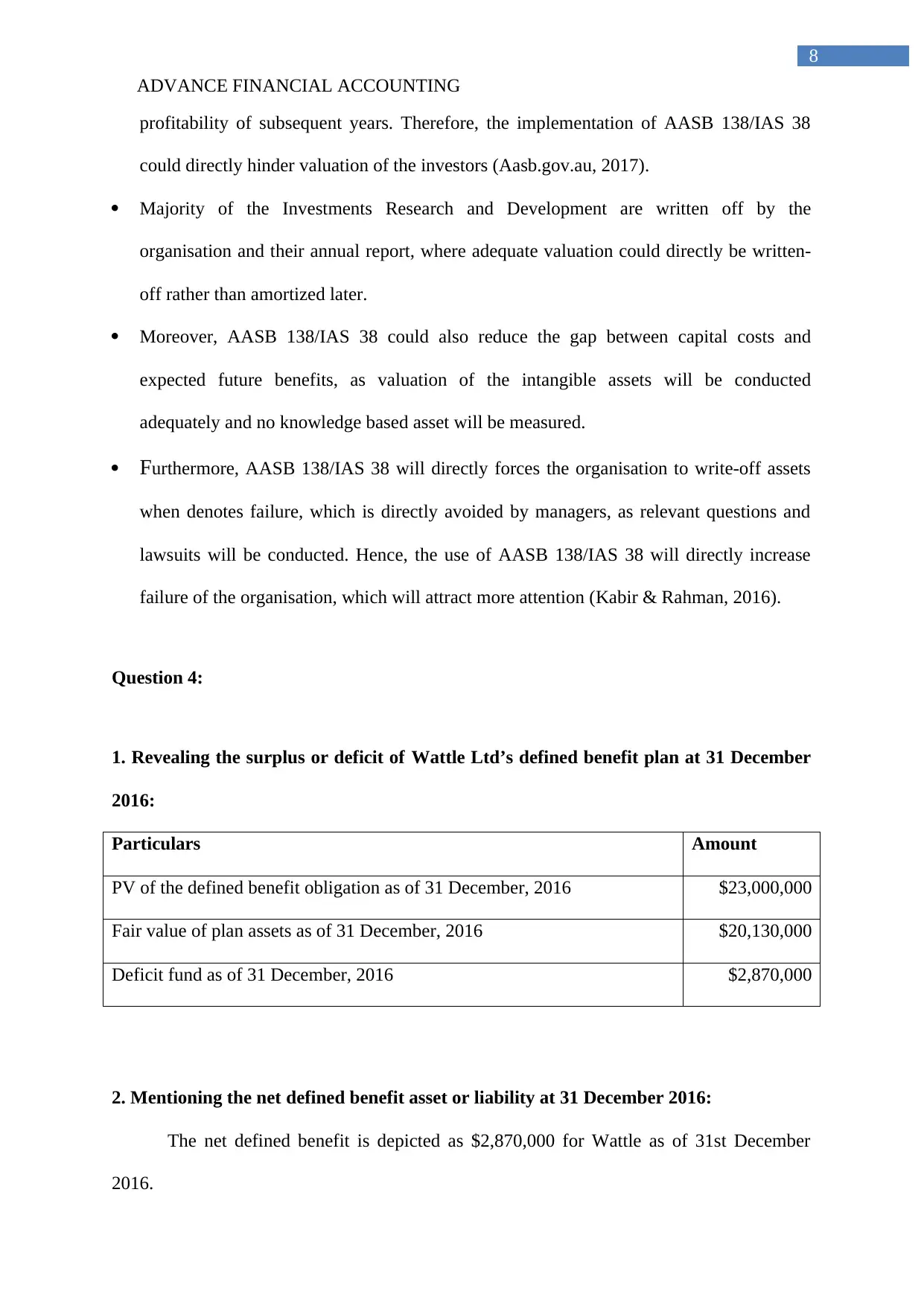
ADVANCE FINANCIAL ACCOUNTING
8
profitability of subsequent years. Therefore, the implementation of AASB 138/IAS 38
could directly hinder valuation of the investors (Aasb.gov.au, 2017).
Majority of the Investments Research and Development are written off by the
organisation and their annual report, where adequate valuation could directly be written-
off rather than amortized later.
Moreover, AASB 138/IAS 38 could also reduce the gap between capital costs and
expected future benefits, as valuation of the intangible assets will be conducted
adequately and no knowledge based asset will be measured.
Furthermore, AASB 138/IAS 38 will directly forces the organisation to write-off assets
when denotes failure, which is directly avoided by managers, as relevant questions and
lawsuits will be conducted. Hence, the use of AASB 138/IAS 38 will directly increase
failure of the organisation, which will attract more attention (Kabir & Rahman, 2016).
Question 4:
1. Revealing the surplus or deficit of Wattle Ltd’s defined benefit plan at 31 December
2016:
Particulars Amount
PV of the defined benefit obligation as of 31 December, 2016 $23,000,000
Fair value of plan assets as of 31 December, 2016 $20,130,000
Deficit fund as of 31 December, 2016 $2,870,000
2. Mentioning the net defined benefit asset or liability at 31 December 2016:
The net defined benefit is depicted as $2,870,000 for Wattle as of 31st December
2016.
8
profitability of subsequent years. Therefore, the implementation of AASB 138/IAS 38
could directly hinder valuation of the investors (Aasb.gov.au, 2017).
Majority of the Investments Research and Development are written off by the
organisation and their annual report, where adequate valuation could directly be written-
off rather than amortized later.
Moreover, AASB 138/IAS 38 could also reduce the gap between capital costs and
expected future benefits, as valuation of the intangible assets will be conducted
adequately and no knowledge based asset will be measured.
Furthermore, AASB 138/IAS 38 will directly forces the organisation to write-off assets
when denotes failure, which is directly avoided by managers, as relevant questions and
lawsuits will be conducted. Hence, the use of AASB 138/IAS 38 will directly increase
failure of the organisation, which will attract more attention (Kabir & Rahman, 2016).
Question 4:
1. Revealing the surplus or deficit of Wattle Ltd’s defined benefit plan at 31 December
2016:
Particulars Amount
PV of the defined benefit obligation as of 31 December, 2016 $23,000,000
Fair value of plan assets as of 31 December, 2016 $20,130,000
Deficit fund as of 31 December, 2016 $2,870,000
2. Mentioning the net defined benefit asset or liability at 31 December 2016:
The net defined benefit is depicted as $2,870,000 for Wattle as of 31st December
2016.
⊘ This is a preview!⊘
Do you want full access?
Subscribe today to unlock all pages.

Trusted by 1+ million students worldwide
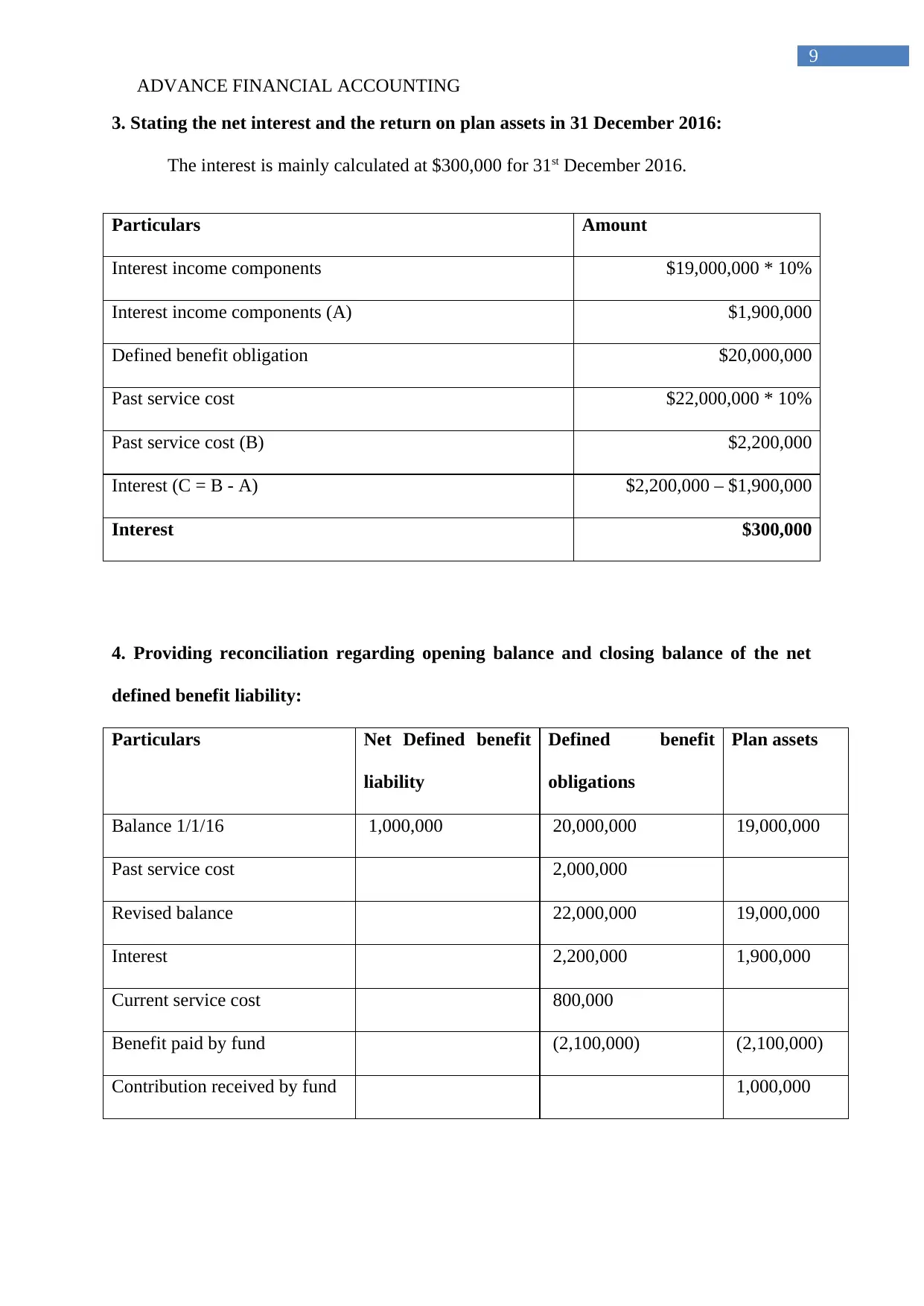
ADVANCE FINANCIAL ACCOUNTING
9
3. Stating the net interest and the return on plan assets in 31 December 2016:
The interest is mainly calculated at $300,000 for 31st December 2016.
Particulars Amount
Interest income components $19,000,000 * 10%
Interest income components (A) $1,900,000
Defined benefit obligation $20,000,000
Past service cost $22,000,000 * 10%
Past service cost (B) $2,200,000
Interest (C = B - A) $2,200,000 – $1,900,000
Interest $300,000
4. Providing reconciliation regarding opening balance and closing balance of the net
defined benefit liability:
Particulars Net Defined benefit
liability
Defined benefit
obligations
Plan assets
Balance 1/1/16 1,000,000 20,000,000 19,000,000
Past service cost 2,000,000
Revised balance 22,000,000 19,000,000
Interest 2,200,000 1,900,000
Current service cost 800,000
Benefit paid by fund (2,100,000) (2,100,000)
Contribution received by fund 1,000,000
9
3. Stating the net interest and the return on plan assets in 31 December 2016:
The interest is mainly calculated at $300,000 for 31st December 2016.
Particulars Amount
Interest income components $19,000,000 * 10%
Interest income components (A) $1,900,000
Defined benefit obligation $20,000,000
Past service cost $22,000,000 * 10%
Past service cost (B) $2,200,000
Interest (C = B - A) $2,200,000 – $1,900,000
Interest $300,000
4. Providing reconciliation regarding opening balance and closing balance of the net
defined benefit liability:
Particulars Net Defined benefit
liability
Defined benefit
obligations
Plan assets
Balance 1/1/16 1,000,000 20,000,000 19,000,000
Past service cost 2,000,000
Revised balance 22,000,000 19,000,000
Interest 2,200,000 1,900,000
Current service cost 800,000
Benefit paid by fund (2,100,000) (2,100,000)
Contribution received by fund 1,000,000
Paraphrase This Document
Need a fresh take? Get an instant paraphrase of this document with our AI Paraphraser
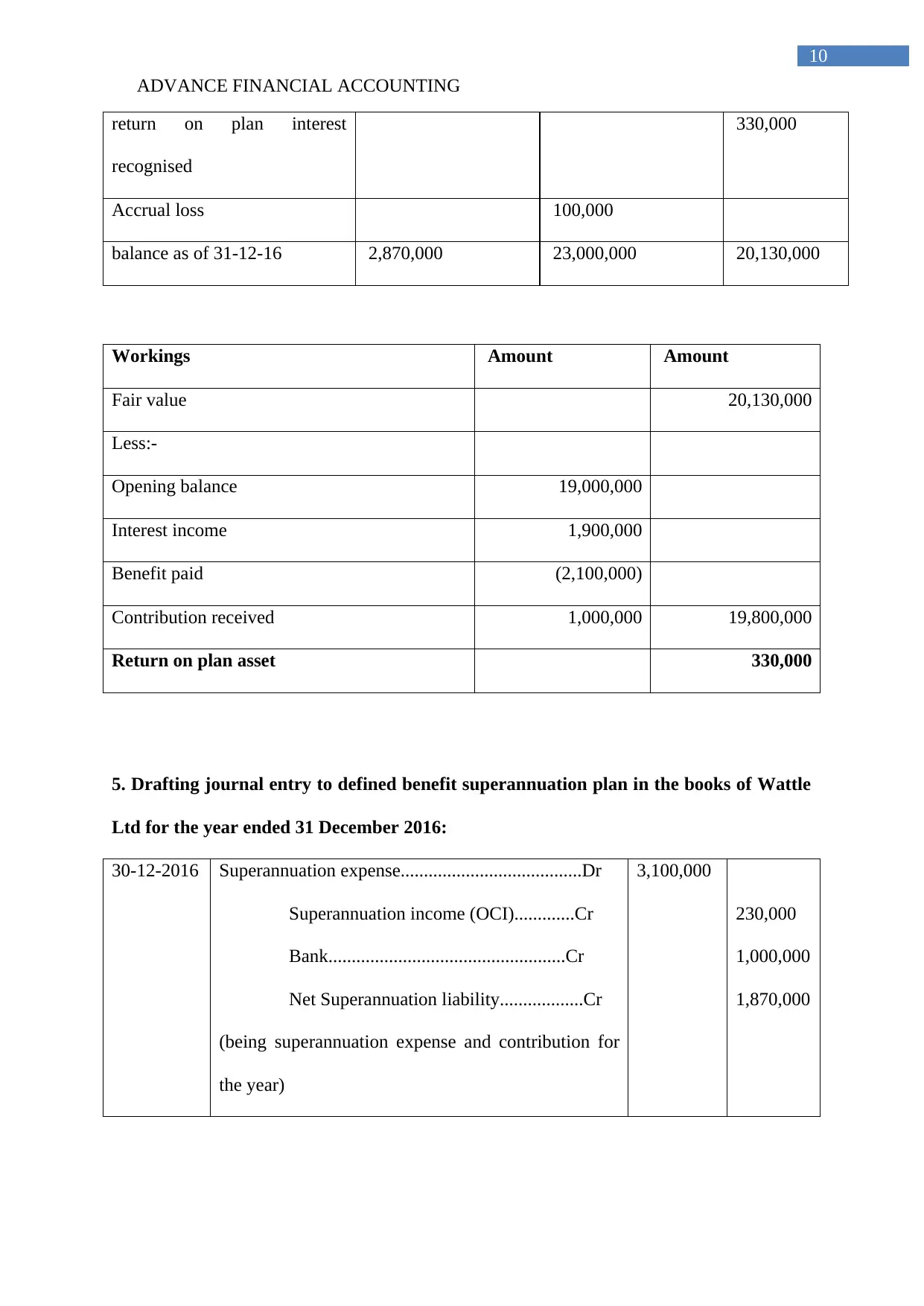
ADVANCE FINANCIAL ACCOUNTING
10
return on plan interest
recognised
330,000
Accrual loss 100,000
balance as of 31-12-16 2,870,000 23,000,000 20,130,000
Workings Amount Amount
Fair value 20,130,000
Less:-
Opening balance 19,000,000
Interest income 1,900,000
Benefit paid (2,100,000)
Contribution received 1,000,000 19,800,000
Return on plan asset 330,000
5. Drafting journal entry to defined benefit superannuation plan in the books of Wattle
Ltd for the year ended 31 December 2016:
30-12-2016 Superannuation expense.......................................Dr
Superannuation income (OCI).............Cr
Bank...................................................Cr
Net Superannuation liability..................Cr
(being superannuation expense and contribution for
the year)
3,100,000
230,000
1,000,000
1,870,000
10
return on plan interest
recognised
330,000
Accrual loss 100,000
balance as of 31-12-16 2,870,000 23,000,000 20,130,000
Workings Amount Amount
Fair value 20,130,000
Less:-
Opening balance 19,000,000
Interest income 1,900,000
Benefit paid (2,100,000)
Contribution received 1,000,000 19,800,000
Return on plan asset 330,000
5. Drafting journal entry to defined benefit superannuation plan in the books of Wattle
Ltd for the year ended 31 December 2016:
30-12-2016 Superannuation expense.......................................Dr
Superannuation income (OCI).............Cr
Bank...................................................Cr
Net Superannuation liability..................Cr
(being superannuation expense and contribution for
the year)
3,100,000
230,000
1,000,000
1,870,000

ADVANCE FINANCIAL ACCOUNTING
11
Workings Profit or Loss Other comprehensive
income
Bank Net DBL (A)
Balance 1 Jan 2016 1,000,000 Cr
Past service cost 2,000,000 Dr
service cost 800,000 Dr
net interest 300,000 Dr
gain on plan assets 330,000 Cr
contribution paid to the
fund
1,000,000 Cr
Actuarial loss on DBO 100,000 Dr
Journal entry 3,100,000 Dr 230,000 Cr 1,000,000 Cr 1,870,000 Cr
Balance 31 Dec 2016 2,870,000 Cr
11
Workings Profit or Loss Other comprehensive
income
Bank Net DBL (A)
Balance 1 Jan 2016 1,000,000 Cr
Past service cost 2,000,000 Dr
service cost 800,000 Dr
net interest 300,000 Dr
gain on plan assets 330,000 Cr
contribution paid to the
fund
1,000,000 Cr
Actuarial loss on DBO 100,000 Dr
Journal entry 3,100,000 Dr 230,000 Cr 1,000,000 Cr 1,870,000 Cr
Balance 31 Dec 2016 2,870,000 Cr
⊘ This is a preview!⊘
Do you want full access?
Subscribe today to unlock all pages.

Trusted by 1+ million students worldwide
1 out of 12
Related Documents
Your All-in-One AI-Powered Toolkit for Academic Success.
+13062052269
info@desklib.com
Available 24*7 on WhatsApp / Email
![[object Object]](/_next/static/media/star-bottom.7253800d.svg)
Unlock your academic potential
Copyright © 2020–2025 A2Z Services. All Rights Reserved. Developed and managed by ZUCOL.





